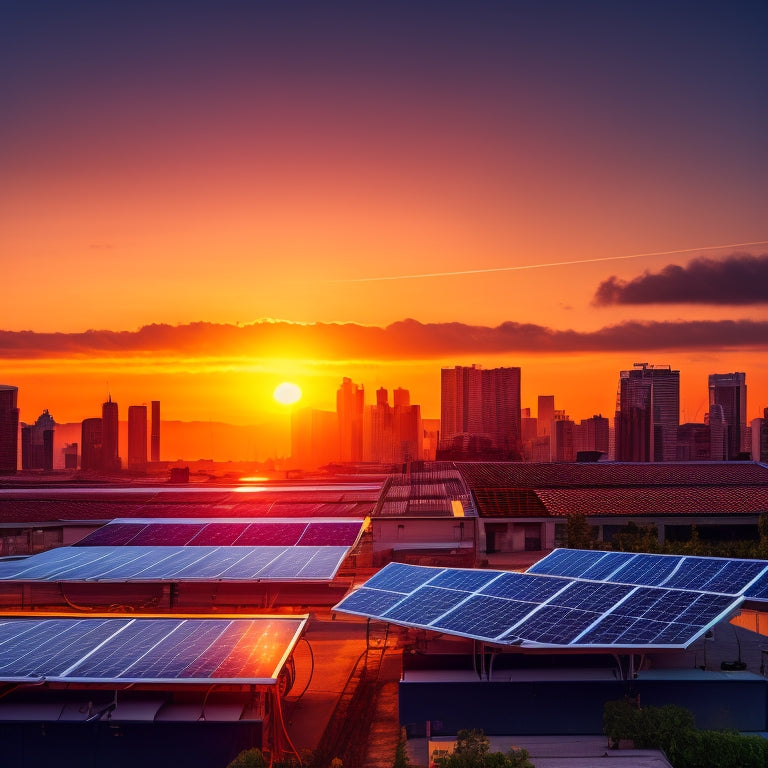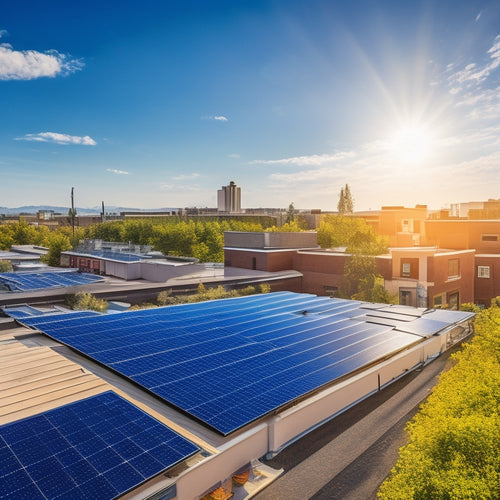
Best Solar Power Inverters for Maximum Efficiency
Share
When selecting a solar power inverter, you'll want to maximize efficiency to utilize the full potential of your solar panel system. Top brands like Enphase, SMA, and Fronius offer advanced technologies that can help. Look for high efficiency ratings, typically ranging from 98-99%, and consider factors like compatibility and warranty. Microinverters, grid-tie inverters, and off-grid inverters each have their own benefits, so evaluate your specific needs and energy goals. By prioritizing efficiency, you'll reduce energy waste and enhance overall performance – and exploring further will reveal the best approach for your unique situation.
Key Takeaways
- Top-rated solar inverter brands like Enphase, SMA, and Fronius offer advanced technology for maximum efficiency.
- Inverter efficiency ratings, typically 98-99%, indicate how well DC power is converted to AC power, with higher ratings reducing energy waste.
- Microinverters provide individual panel optimization, real-time monitoring, and enhanced energy harvesting for superior performance.
- When choosing an inverter, consider factors like compatibility, warranty, and features like MPPT and smart technology for optimal energy output.
- Inverter sizing and configuration should be based on maximum power output, environmental factors, and load management strategies to ensure peak performance.
Top-Rated Solar Inverter Brands
When it comes to utilizing the power of solar energy, the quality of your inverter plays an essential role. You need a dependable and efficient solar inverter to convert DC power from your solar panels into usable AC power for your home or business.
With various solar inverter types available, it's vital to choose a top-rated brand that offers advanced inverter technology. Leading brands like Enphase, SMA, and Fronius have made significant inverter technology advancements, offering high-efficiency models with improved performance and durability.
Enphase's microinverters, for instance, provide individual panel optimization, while SMA's string inverters offer high-power density and flexibility. Fronius's Eco and Symo inverters are known for their reliability and advanced monitoring capabilities.
When selecting a solar inverter brand, you should consider factors like efficiency, compatibility, and warranty. Look for brands that offer advanced monitoring and tracking features, as well as strong customer support.
Understanding Inverter Efficiency Ratings
Plunge into the world of inverter efficiency ratings, a critical aspect of solar power systems that can greatly influence your energy harvest. As you investigate your options, you'll come across various efficiency ratings, which can be confusing if you're not familiar with them.
Fundamentally, an inverter's efficiency rating represents how well it converts DC power from your solar panels into AC power for your home or business.
When comparing inverters, look for the maximum power point tracking (MPPT) efficiency, which is usually around 98-99%. This indicates how well the inverter can extract energy from your solar panels during peak sun hours.
You should also consider the European efficiency, which takes into account the inverter's performance under various operating conditions. A higher European efficiency means the inverter will perform better in real-world scenarios.
Keep in mind that a higher efficiency rating doesn't always translate to a longer inverter lifespan. However, it does imply that the inverter will waste less energy as heat, which can increase its reliability and reduce maintenance costs over time.
When making an efficiency comparison, consider your specific energy needs and the inverter's overall performance to guarantee you're getting the best value for your investment.
Key Features to Look for
Choosing the appropriate solar power inverter entails evaluating a variety of essential characteristics that assure peak performance, reliability, and safety.
When selecting an inverter, you'll want to take into account the type of installation, system size, and compatibility with your solar panel array. Look for inverters with smart technology that enable real-time monitoring, remote troubleshooting, and automatic software updates. This feature will help you stay on top of your system's performance and identify any potential issues promptly.
You should also pay attention to the inverter's maximum power point tracking (MPPT) capabilities, which enhance energy harvesting from your solar panels. Confirm the inverter's MPPT range aligns with your panel's voltage output to maximize energy production.
Additionally, review the installation guidelines and certifications, such as UL and NEC compliance, to guarantee a safe and code-compliant installation. By evaluating these key features, you'll be able to find an inverter that meets your specific needs and provides superior performance for your solar power system.
Grid-Tie Inverters for Homes
Most households require a grid-tie inverter to efficiently convert DC power from their solar panels into AC power that can be fed into the grid and offset their electricity bills.
When selecting a grid-tie inverter for your home, you'll want to take into account the grid tie benefits, such as maximum power point tracking (MPPT) and high efficiency rates, often above 95%. This means you'll get the most out of your solar panels' energy production.
During installation, you'll need to take into account the inverter's compatibility with your existing electrical infrastructure.
Verify the inverter can handle the voltage and current output of your solar panels, and that it's installed in a well-ventilated area to prevent overheating.
Installation considerations also include verifying the inverter is easily accessible for maintenance and monitoring, as well as meeting local building codes and regulations.
Off-Grid Inverters for Remote Areas
Living off the grid often means relying on solar power as a primary source of energy, and off-grid inverters play an essential role in converting DC power from solar panels into AC power for remote homes or cabins.
You'll need an inverter that can efficiently manage your solar power system, especially when you're not connected to the grid. When choosing an off-grid inverter, consider one that supports solar battery integration, guaranteeing a seamless shift between solar power and battery backup. This integration allows you to store excess energy generated during the day for use at night or during periods of low sunlight.
When installing an off-grid inverter in a remote area, you'll face unique challenges, such as limited access to technical support and harsh environmental conditions.
Look for an inverter with a durable design, built-in monitoring capabilities, and remote firmware updates to minimize maintenance and troubleshooting. Additionally, consider the inverter's maximum power point tracking (MPPT) capability, which optimizes energy production from your solar panels.
Microinverters for Maximum Output
When you opt for microinverters, you'll benefit from module-level power tracking, which guarantees each panel operates at its maximum potential.
This individual panel optimization leads to enhanced energy harvesting, as underperforming panels no longer drag down the entire system.
Module-Level Power Tracking
Your solar panel array's performance is only as strong as its weakest link, and traditional string inverters can be held back by underperforming panels. This is where module-level power tracking comes in. By using microinverters, each panel operates independently, allowing for maximum power output.
In a traditional string inverter setup, the entire array's performance is limited by the weakest panel. This can be due to various factors such as shading, debris, or manufacturing defects. With module-level power tracking, each panel is optimized to produce its maximum potential, resulting in increased overall energy production.
This technology also provides real-time monitoring and diagnostics, allowing you to identify and address any issues promptly.
When selecting microinverters, consider module compatibility and installation techniques to guarantee seamless integration with your existing solar panel array. Look for microinverters that support a wide range of module types and are designed for easy installation.
Individual Panel Optimization
Optimization opportunities abound in solar panel arrays, and individual panel optimization is a key strategy for maximizing energy output. By focusing on each panel's performance, you can overcome common issues like panel shading, which can greatly reduce energy production.
Microinverters are a popular solution for individual panel optimization, as they convert DC power from each panel to AC power, allowing for real-time monitoring and optimization.
Here are some benefits of individual panel optimization:
-
Improved energy harvest: By optimizing each panel's performance, you can increase overall energy production and reduce losses due to panel shading or mismatch.
-
Enhanced monitoring and diagnostics: With microinverters, you can monitor each panel's performance in real-time, identifying issues and allowing for quick troubleshooting and maintenance.
-
Increased flexibility in installation design: Microinverters enable you to design your solar array with more flexibility, as you're no longer limited by the constraints of traditional string inverters.
- Greater installation benefits: Individual panel optimization can lead to higher ROI and faster payback periods, making it a persuasive choice for solar installations.
Enhanced Energy Harvesting
How do you squeeze every last watt out of your solar panel array? By leveraging microinverters, you can access the full potential of your solar energy system.
These advanced inverter technologies allow each panel to operate independently, maximizing energy harvesting and minimizing losses. With microinverters, you can overcome the limitations of traditional string inverters, which can be held back by the weakest performing panel.
By adopting microinverter technology, you can take advantage of the latest solar energy trends. This approach enables real-time monitoring and optimization of individual panels, ensuring that each one operates at its maximum capacity.
As a result, you can increase your overall energy output and reduce the impact of shading, debris, or other environmental factors.
In addition, microinverters provide greater design flexibility, allowing you to accommodate complex roof layouts and maximize your available space.
By choosing a microinverter-based system, you can access the full potential of your solar panel array and reap the benefits of enhanced energy harvesting.
With advanced inverter technologies like microinverters, you can stay at the forefront of solar energy innovation and maximize your return on investment.
Inverter Sizing and Configuration Tips
When sizing an inverter for your solar power system, getting it right is essential. You want to verify that your inverter can handle the maximum power output of your solar panels while also meeting the energy demands of your load.
To achieve peak performance, follow these inverter sizing and configuration tips:
-
Calculate your inverter capacity based on the maximum power output of your solar array, considering factors like temperature, shading, and panel degradation.
-
Consider your load management strategy, prioritizing critical loads like refrigeration or lighting, and designing your system to meet their energy needs during periods of low solar irradiance.
-
Confirm your inverter is compatible with your solar panel configuration, including the type, voltage, and current ratings of your panels.
- Consider oversizing your inverter to accommodate future expansions or upgrades to your solar array.
Frequently Asked Questions
Can I Install a Solar Inverter Myself or Do I Need a Professional?
You can attempt a DIY installation, but be aware that inverter safety risks are high without proper training, so it's recommended you hire a professional to guarantee a safe and efficient solar power system.
How Long Does a Typical Solar Inverter Warranty Last?
Fast forward to the Middle Ages, where knights protected their castles; now, you're protecting your solar investment! Typically, you'll find a 5-10 year warranty on a solar inverter, covering defects and ensuring a long inverter lifespan, with some manufacturers offering extended warranty coverage up to 25 years or more.
Are Solar Inverters Susceptible to Cyber Attacks or Hacking?
You should be aware that solar inverters can be vulnerable to cyber attacks, so you'll want to guarantee yours has strong cybersecurity measures in place to mitigate inverter vulnerabilities and protect your system from potential hacking threats.
Can I Use a Solar Inverter With a Generator or Wind Turbine?
You can integrate a solar inverter with a generator or wind turbine in a hybrid energy system, guaranteeing seamless power shift and optimization; however, you'll need to verify solar inverter compatibility with the alternative energy source's output characteristics.
Do Solar Inverters Require Regular Maintenance or Cleaning?
You'll find that a well-maintained solar inverter, like the one at California's Mojave Desert solar farm, can last up to 25 years; regular cleaning and checks guarantee peak inverter performance, as dust and debris can reduce efficiency by up to 20%.
Conclusion
As you finalize your solar power system, it's likely that the importance of a high-efficiency inverter has become glaringly clear. Coincidentally, you've narrowed it down to the top-rated brands and grasped the significance of inverter efficiency ratings. Now, you're ready to maximize your energy output with the perfect inverter configuration, whether it's for your home, a remote area, or even ideal microinverter performance. Your pursuit of efficiency has led you to this moment - it's time to utilize the full potential of your solar power system.
Related Posts
-

Energy-Efficient Home Upgrades for Cost Reduction
To reduce costs with energy-efficient home upgrades, focus on essential improvements like smart thermostats, energy-e...
-

High-Performance Solar Solutions for Sustainable Living
High-performance solar solutions are your gateway to sustainable living, maximizing energy efficiency while considera...
-

Solar Energy Solutions for Small Businesses
Switching to solar energy can be a game changer for your small business. You'll enjoy significant cost savings on mon...


